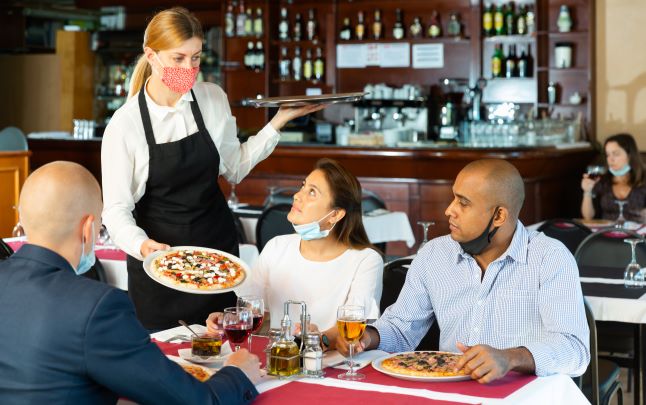Just like many other industries, the COVID-19 pandemic greatly impacted the restaurant industry. With many restaurants having to temporarily shut their doors due to lockdowns and other restrictions imposed by the government, the restaurant industry faced setbacks starting in 2020 that continued into 2021.
As we begin to venture outside again with the pandemic slowing down, restaurant owners still face many significant challenges when it comes to operating their business. With the increased reliance on technology during the pandemic, many restaurants have started realizing that their online presence is just as important as their in-person presence.
A lot of the technology that restaurants are embracing have been around for years, such as third-party ordering and direct online ordering. Even so, it took the COVID-19 pandemic to force the restaurant industry to use these technologies to a fuller extent. This technology is making it possible for restaurants to not only recover from the losses during the pandemic, but to grow as well. By the end of 2022, the food industry is expected to bring in a whopping $899 billion in sales.
Home Delivery Services
With the ability to order food from the convenience of your smart phone, many consumers turned to this when unable to go out to restaurants in-person during the COVID-19 lockdown. Many restaurants who have already been offering home delivery services needed to give their system an upgrade due to the spread of Coronavirus. From food handling to delivery methods, restaurants had to adapt to social distancing guidelines. With many third-party food delivery applications offering contactless delivery, it allowed restaurants to still bring in revenue while still following the strict COVID-19 guidelines enforced by the government. These applications allow you to still get food from your favorite Italian restaurant, even if you can’t go there in person.
Labor Shortage
Even with restaurants opening back up, it didn’t all go back to normal. When restaurants first started opening back up, it was hard to find people who wanted to work in the customer service industry due to fears of getting sick. These labor shortages are still affecting the restaurant industry in 2022, even though the lockdown regulations have been lifted. This has forced many restaurants to be open for less days and less hours. Labor shortages were also found in the trucking industry and with many restaurants relying on these workers to deliver their food, these restaurants had to start changing their menus to accommodate the lack of certain meat and produce items. Due to this labor shortage, hourly labor costs have increased by 8.6% in 2022 alone, forcing restaurants to downsize their staff in order to pay their workers while still bringing in revenue.
Food Supply and the Supply Chain
Supply chain problems caused multiple issues for restaurant owners. There were supply shortages of everything, from takeaway containers to fresh produce. The supply chain has not fully recovered from the COVID-19 pandemic as of 2022, so many restaurant owners are facing increasing prices due to the lack of supply to meet the large demand for these products.
Even though labor shortages are improving, the restaurant industry is still dealing with very high prices for food, especially when it comes to poultry, meat, and fish. Products that used to cost $11 or $12 are now going for either double or even triple the original price. Facing both supply chain issues and rising inflation, restaurant owners will probably have to continue dealing with this challenge.
Vaccination Restrictions Lifted
Even though lockdown was over, many major cities like New York and Philadelphia adopted a “No Vax, No Entry” restriction. With over 68% of the American population having received a complete vaccination, regulations began easing up and more people were allowed to go back into public spaces like restaurants. This “No Vax, No Entry” rule also helped to encourage consumers to get vaccinated so that they could enjoy sit down meals in a pre-pandemic fashion. Now, in late 2022, most restaurants don’t have to follow the vaccination-only regulations and are able to now accommodate more guests.
Digitalization of the Restaurant Industry
These past two years have completely transformed the way people function and their expectations of the restaurant industry. Consumers have become more dependent on technology than ever before, as seen through the rising popularity of contactless payment methods and online ordering. For many restaurants to survive the COVID-19 pandemic, owners had to offer discounts as customers shifted to online ordering. Online ordering is more expensive than dining in-person as you have to pay tax, a service fee, a delivery fee, and a tip for your driver. Now that lockdown restrictions have lifted, many consumers still expect discounts, extra reward incentives, and other reward-earning programs for their favorite restaurants.
The digitalization of the restaurant industry has helped by creating a new digital working model. Serving customers online instead of in-person helped restaurant owners to reduce costs and increase performance. With the labor shortage in full force during the pandemic, technology has been helpful because it reduces the amount of employees needed to service a guest. Technology has also been a great way for restaurants losing employees to recruit new ones.
A large part of the digitalization of the restaurant industry is new strategies for marketing. Restaurant marketing has become increasingly necessary during COVID-19 since in-person word of mouth became a thing of the past. Consumers flocked to social networking platforms during the pandemic to stay connected with the world around them, which includes restaurants. Now more than ever, a restaurant’s online presence is crucial to its overall success. Having an online presence allows restaurants to reach new customers and engage with current ones.
America’s GPD is Impacted by the Restaurant Industry
As one of the largest industries, restaurants contribute significantly to the American economy. With the losses caused by the pandemic, restaurants are still trying to recoup their losses. Even so, restaurant sales in 2022 have been trending in a positive direction. According to the United States Census, the ongoing COVID-19 pandemic caused up to $280 billion in losses for restaurants and bars. The multitude of mandates negatively impacted the entire food industry’s economy, but it seems that these industries are turning things around in 2022.




